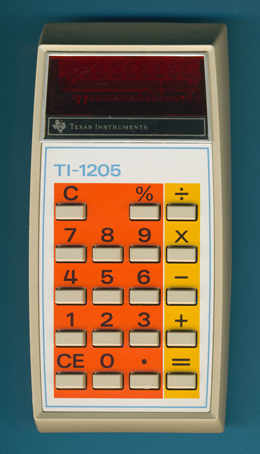
DATAMATH CALCULATOR MUSEUM
 |
DATAMATH CALCULATOR MUSEUM |
Texas Instruments TI-1205
| Date of introduction: | 1976 | Display technology: | LED-stick |
| New price: | Display size: | 8 | |
| Size: | 5.5" x 2.8" x 1.4" 138 x 70 x 35 mm3 |
||
| Weight: | 6.0 ounces, 170 grams | Serial No: | 1016099 |
| Batteries: | 2*AA NiCd | Date of manufacture: | wk 19 year 1977 |
| AC-Adapter: | AC9130 | Origin of manufacture: | USA (LTA) |
| Precision: | Integrated circuits: | TMS0972 | |
| Memories: | |||
| Program steps: | Courtesy of: | Joerg Woerner |

![]()


 Texas
Instruments took in 1976 in conjunction with mathematics educators at two major
universities an initiative to introduce a group of 6 calculators for educational
use. Including the Little Professor,
the limited function ABLE calculator, the colorful
TI-1205 and TI-1255, the TI-30
and the sophisticated SR-51-II,
these calculators helped students understand and use math concepts from
kindergarten through college and career.
Texas
Instruments took in 1976 in conjunction with mathematics educators at two major
universities an initiative to introduce a group of 6 calculators for educational
use. Including the Little Professor,
the limited function ABLE calculator, the colorful
TI-1205 and TI-1255, the TI-30
and the sophisticated SR-51-II,
these calculators helped students understand and use math concepts from
kindergarten through college and career.
The TI-1205 is based on the TI-1200
but includes rechargeable NiCd-batteries instead the standard 9V block battery.
To enhance the readability of the keyboard both the size of the numerals and the
color-scheme was improved.
 Disassembling
the TI-1205 with
Date code 1977 LTA and manufactured in May
1977 in Lubbock, Texas reveals an internal construction identical with the
TI-1255. Instead of the 9V battery found in the original
TI-1200/TI-1250
design, the TI-1205 makes use of 2 rechargeable, AA-sized NiCd (Nickel Cadmium)
batteries. The printed circuit board (PCB) of the TI-1205 adds both the charging circuit for
the batteries and a step-up converter to generate the 9V supply of the
TMS0972
single-chip calculating circuit to the design known from the TI-1250.
Disassembling
the TI-1205 with
Date code 1977 LTA and manufactured in May
1977 in Lubbock, Texas reveals an internal construction identical with the
TI-1255. Instead of the 9V battery found in the original
TI-1200/TI-1250
design, the TI-1205 makes use of 2 rechargeable, AA-sized NiCd (Nickel Cadmium)
batteries. The printed circuit board (PCB) of the TI-1205 adds both the charging circuit for
the batteries and a step-up converter to generate the 9V supply of the
TMS0972
single-chip calculating circuit to the design known from the TI-1250.
![]() Please notice that both the Klixon™-style
keyboard and the TMS0972 would support the 4-key memory of
the TI-1255.
Please notice that both the Klixon™-style
keyboard and the TMS0972 would support the 4-key memory of
the TI-1255.
Learn
more about the evolution of the TI-1200 between March 1975 and its discontinuation in 1977.
 Learn more about the different
Product Labels used with the TI-1200
- here at the Datamath Calculator Museum we classify the featured TI-1205 as
Hardware Version 3A, PCB Type 4 and Product Label Style 6.
Learn more about the different
Product Labels used with the TI-1200
- here at the Datamath Calculator Museum we classify the featured TI-1205 as
Hardware Version 3A, PCB Type 4 and Product Label Style 6.
The TI-1205 is by far the most colorful and exotic calculator within the TI-12xx
line.
Fellow collectors - if you own a Texas Instruments TI-1205 calculator, please report us the serial number and date code from the back of the calculator for our Database.
 On September 17, 2009 we were able to celebrate
reunion of the calculators featured in the TI Learning Center
Sales Leaflet CB-272 including three of the rarest portable electronic calculators.
On September 17, 2009 we were able to celebrate
reunion of the calculators featured in the TI Learning Center
Sales Leaflet CB-272 including three of the rarest portable electronic calculators.
| TI-1205.
Four function capability for upper elementary students.
Ideally suited for use with Texas Instruments 4-6 grade level “Elementary Mathematics Concepts with Calculators™” learning kit, the rechargeable TI-1205 meets all the criteria for beginning use of full-function calculators as described in the December 1975 Newsletter of the National Council of Teachers of Mathematics. The TI-1205 features a colorful face with large, easy-to-read numerals. A bright, 8-digit display shows calculator overflow indication, and a negative sign, just to the left of displayed numbers. The TI-1205 adds, subtracts, multiplies, divides – all in full-floating decimal. And there’s an automatic constant for multiplication/division of a series of numbers by one number to or from a series of numbers. Algebraic entry lets students enter numbers and press keys as they would write them on paper. Clearly labeled, easy-to-handle keys provide a positive “click” to assure students that a number has been entered. A separate clear entry key lets them clear a mistake without repeating the entire problem. When
used in conjunction with 4-6 grade level “Elementary Mathematics
Concepts with Calculators”, developed by the © Texas Instruments, 1976 |
If you have additions to the above article please email: joerg@datamath.org.
© Joerg Woerner, December 5, 2001. No reprints without written permission.